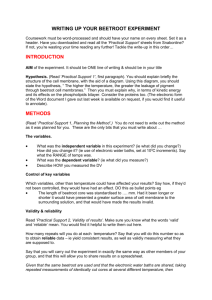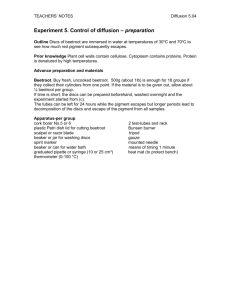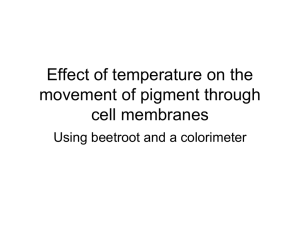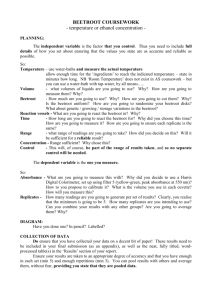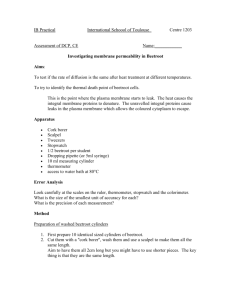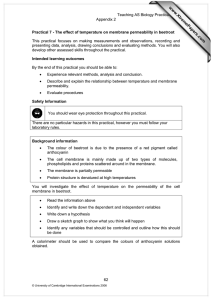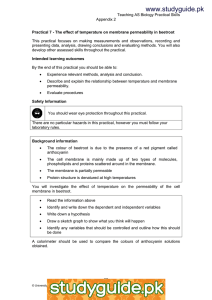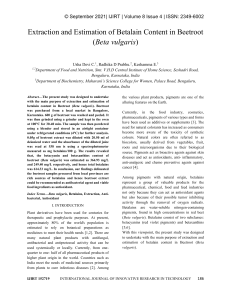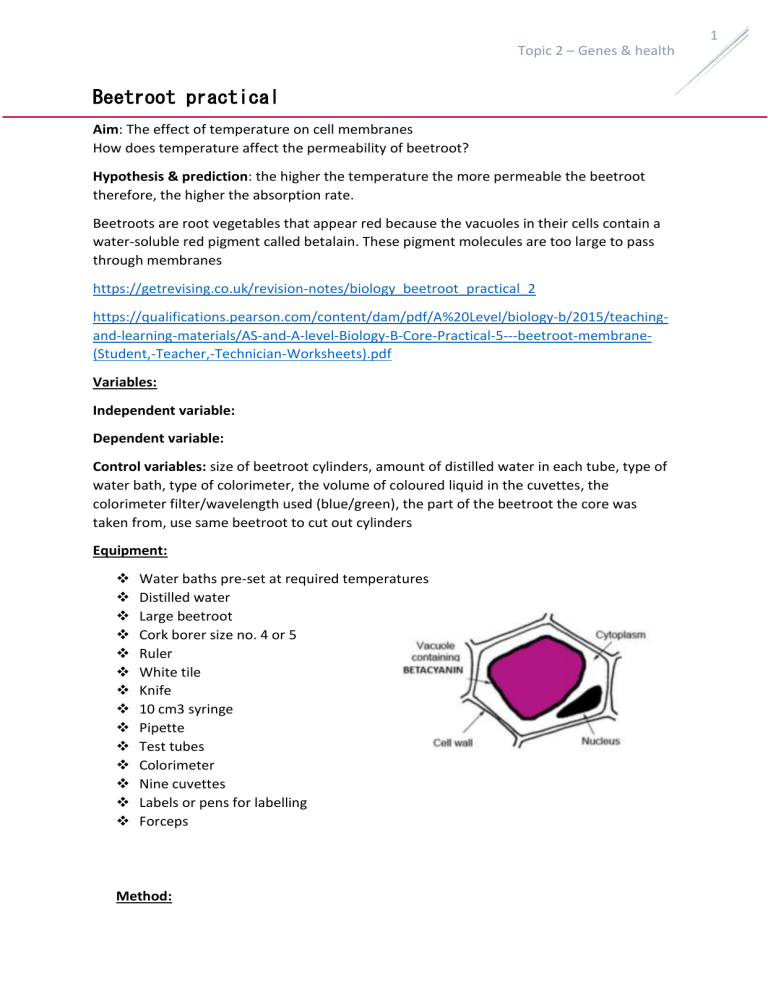
1 Topic 2 – Genes & health Beetroot practical Aim: The effect of temperature on cell membranes How does temperature affect the permeability of beetroot? Hypothesis & prediction: the higher the temperature the more permeable the beetroot therefore, the higher the absorption rate. Beetroots are root vegetables that appear red because the vacuoles in their cells contain a water-soluble red pigment called betalain. These pigment molecules are too large to pass through membranes https://getrevising.co.uk/revision-notes/biology_beetroot_practical_2 https://qualifications.pearson.com/content/dam/pdf/A%20Level/biology-b/2015/teachingand-learning-materials/AS-and-A-level-Biology-B-Core-Practical-5---beetroot-membrane(Student,-Teacher,-Technician-Worksheets).pdf Variables: Independent variable: Dependent variable: Control variables: size of beetroot cylinders, amount of distilled water in each tube, type of water bath, type of colorimeter, the volume of coloured liquid in the cuvettes, the colorimeter filter/wavelength used (blue/green), the part of the beetroot the core was taken from, use same beetroot to cut out cylinders Equipment: Water baths pre-set at required temperatures Distilled water Large beetroot Cork borer size no. 4 or 5 Ruler White tile Knife 10 cm3 syringe Pipette Test tubes Colorimeter Nine cuvettes Labels or pens for labelling Forceps Method: 2 Topic 2 – Genes & health 1) Use a cork borer, knife and ruler to cut 8 x 1cm cylinders of beetroot over a white tile. 2) Place all the cut pieces in a beaker of distilled water & leave overnight to remove any dye (betalains) released when the beetroot was cut. 3) Wash and blot dry (with filter paper or a tissue) the 8 pieces of beetroot. 4) Use a syringe to add 10 cm3 of distilled water to eight test tubes. Label each test tube with a 5) temperature from the pre-set range. 6) Prepare eight water baths pre-set to a range of temperatures between 0 °C and 70 °C temperatures (e.g. 0°C, 10°C, 20°C, 30°C, 40°C, 50°C, 60°C, 70°C). 7) Check the temperature of each bath is correct using a thermometer. It is unlikely to be exactly the desired temperature. Record the actual temperature and use this in your table and graph. 8) Once at the desired temperature, add a piece of beetroot to each boiling tube and leave for 20 minutes. 9) Remove the beetroot pieces gently with a pair of forceps and then shake the tubes to disperse the dye. 10) Set a colorimeter to percentage absorbance on the blue/green filter. Calibrate by filling a cuvette with distilled water first then add 2cm³ of beetroot solution from the first temperature to a new cuvette. 11) Place this cuvette into the colorimeter to read the percentage absorbance. Repeat this for all other pieces. Record your results in a suitable table. 12) Plot a graph of absorption against temperature. Results table & graph: Absorption (%) 0.66 0.20 0.59 0.83 2.00 2 Absorption (%) Temperature (°C) 18 31 36 49 53 2,5 1,5 1 0,5 0 0 10 20 30 Temperature (°C) 40 50 60 3 Topic 2 – Genes & health Conclusion: The higher the temperature, the higher the absorption rate. For example, at 18°C the absorption rate was 0.66%, whilst at 49°C the absorption rate was 0.83%. Evaluation: 1) Criticises the method 2) Identifies reliability, accuracy & validity 3) Conclusions & evaluation together are sometimes known as the ‘discussion’ Risk assessment Water baths at temperatures above 50 °C may scald. Take care when removing lids to allow steam to escape away from the face or body. Take care with sharp items such as the cork borer and knife.
